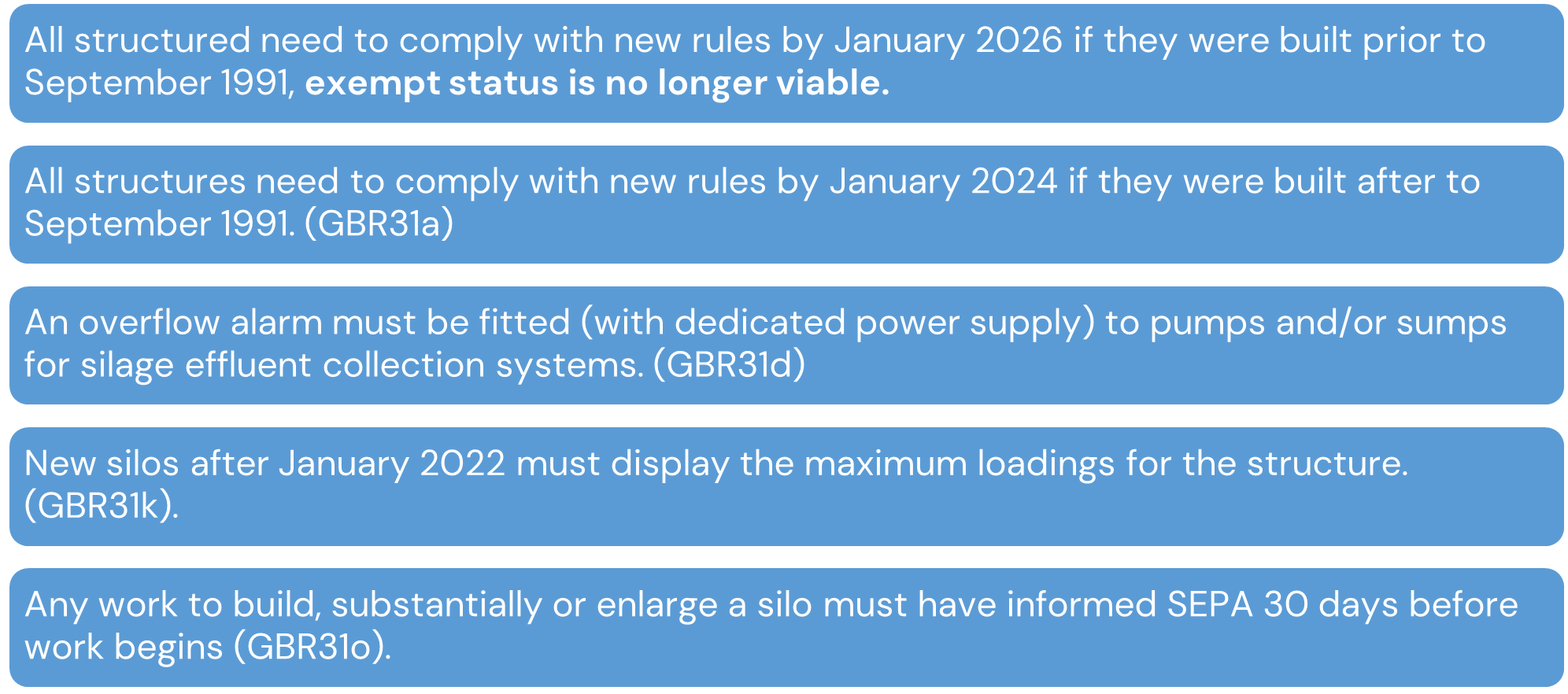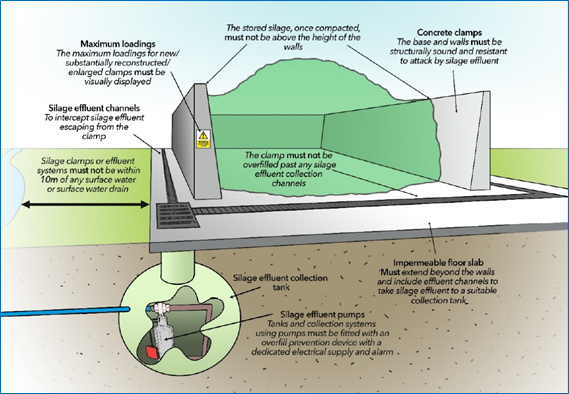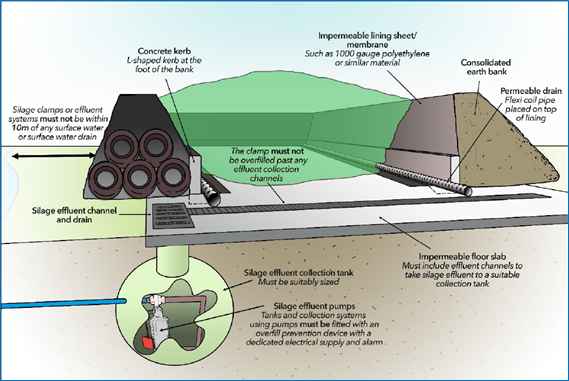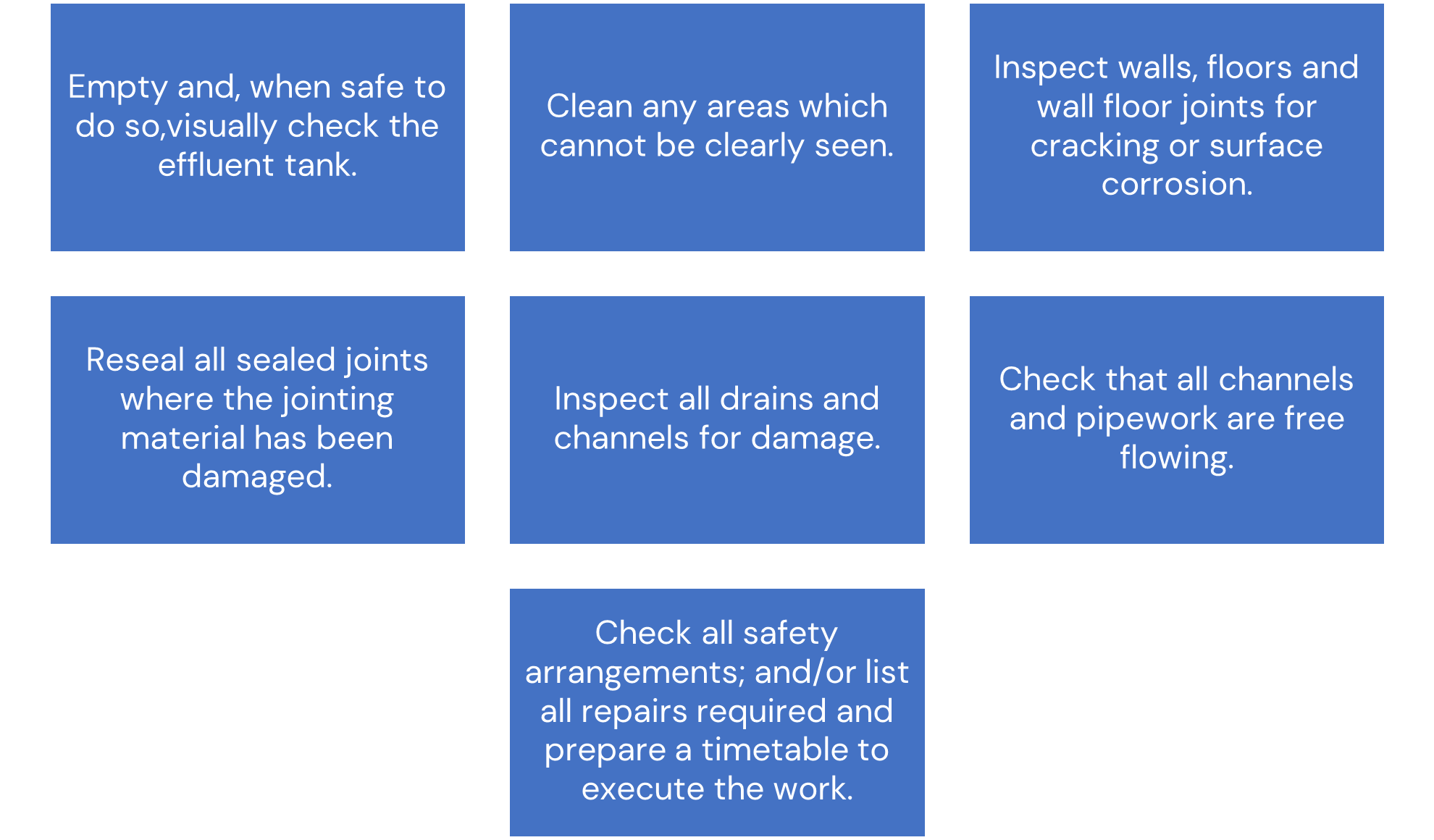Silage – any forage crop (classed as any plant drown for a commercial purpose, including cereals, root crops, grass and trees), including draff (the residue of grain after fermentation of the grain in a brewing or distilling process), which is being or has been conserved by fermentation or preservation or both, including the use of additives.
Silage effluent – effluent produced from any forage crop which is being made or has been made into silage or a mixture consisting wholly of or containing such effluent, rainwater or groundwater, emanating from a silo, silage effluent collection system or drain.
Silage effluent has a Biochemical Oxygen Demand (BOD) of up to 200 times that of raw sewage. If silage effluent is allowed to enter a watercourse it rapidly strips oxygen from the water, killing fish, plants and other aquatic life. A clamp containing 500 tonnes of unwilted silage has the same polluting potential as the daily untreated sewage from a city of approximately 200,000 people (i.e. about the size of Aberdeen). Silage effluent is also highly acidic and attacks steel and concrete surfaces, causing deterioration of cracks and joints in silo floors, collection channels and tanks, making it very difficult to contain and collect all the effluent. As a result, the management of this material needs to be controlled and maintained.
The management of silage and silage effluent needs to follow the General Binding Rules. New amendments were introduced on 1st January 2022. For full details Farming Water Scotland have produced guidance, which can be found here.
The new amendments under the General Binding Rules include:
- Silage bales or bulk bags should not be stored, opened, or unwrapped within 10 m of any surface water or opening to surface water drain (GBR29).
- When not in use bulk bags need to be resealed (GBR29) and have a facility to remove effluent safely.
- Silage effluent, containing mainly rainwater, can be put in constructed farm wetland (GBR 30 rules apply).
Silos, referring to any structure used for making or storing silage over winter when storing silage, must have structurally sound impermeable floor with no cracks and have suitable effluent collection system in place. The following rules also apply to the storage of draff and crops for energy production:

Silage can be made in clamps, bales or bulk bags. In all cases silage and silage effluent must be handled and managed carefully to ensure no pollution occurs.
Where silage is made and stored in bales or bags they must:
- be situated at least 10 m away from any surface water drains, ditch, burn, river, loch or shoreline when stored, opened or unwrapped.
- be enclosed and sealed using impermeable membranes or bags, and
- where bulk bags are used, be sited on a firm level surface and incorporate a facility to safely remove effluent and be resealed when not in use.
The essential design requirements are to provide facilities, which will contain the effluent produced during the making and storage of silage, to collect the effluent via a drainage system and lead it to a store of an adequate capacity. With proper maintenance, the whole system must continue to comply with the performance standards for at least 20 years.
Professionally prepared plans and specifications for all the work are an essential requirement so that the necessary standards are attained on any site. SEPA will require to see these before work commences. Figure 1 and Figure 2 show detailed information of the structure and requirements needed for Silage clamps and Earth bank clamps. These requirements must be followed and cross compliance must be adhered to. The Farm Advisory Service has produced guidance on Farm Buildings and Infrastructure: How to Comply with Current Legislation. Details of requirements for new structure can be found here.
Farming Water Scotland Know the Rules Factsheet 3: Silage provide details on the specific requirements for the storage of silage and silage effluent.

Figure 1 Silage Clamp

Figure 2 Earth bank clamps
For all new silage pits, or substantially reconstructing/enlarging an existing silage pit, you must contact SEPA at least 30 days before building the new structure. In addition, you must consult with an engineer and be able to provide the design plans with a sign-off certificate.
Before beginning a new silage pit it is recommended to contact your local authority to gauge whether planning permission is required. All structures must comply with a basic set of constructions standards, be structurally sound with impermeable floor, no cracks, and have a suitably sized effluent collection facility.
A building warrant for a silage pit will be required.
Please note:
- Silage stores constructed before September 1991 no longer have exempt status. This means they must comply with a basic set of construction standards [by 2026]
- Silage stores constructed after September 1991 (or that were substantially reconstructed or enlarged after 1st Sept 1991) must comply with a basic set of construction standards [by 2024]
Please note that for silage silos/pits built, reconstructed, or enlarged after 1 September 1991 must be made compliant to comply with British Standard. For more information, please visit NetRegs.

Regular inspections of the drainage and storage units must be carried out to ensure that the structures do not show signs of corrosion, cracking of concrete or fractured pipes. Silage effluent is highly acidic and can compromise the structure of the storage unit. Ensuring that you regularly inspect your storage containers can reduce the likelihood of effluent being released into waterbodies.
- Farming Water Scotland has produced Know the Rules Factsheet 4: Maintaining silage storage systems were you can find out key information to ensure you comply with regulations.
- Please watch Silage Pit Maintenance video for key information.
It is recommended that all adjacent ditches, burns or watercourses should be checked regularly (preferably daily) for signs of pollution, particularly when silage effluent is being produced just downstream of the point of discharge of the surface water drainage system from the farm. If any pollution is found, immediate action should be taken to remedy the situation. SEPA must be notified. Over winter it is important to ensure that weekly checks on watercourses are made to check for silage effluent pollution. Weak rain driven silage effluent can still cause pollution of watercourses during the winter.
Regular checks need to be carried out each time the silos is emptied. Ensure that you do not enter the tank when poisonous gas may be present:

Where silage is made and stored in bales or bags they must:
- Be situated at least 10 m away from any surface water drains, ditch, burn, river, loch or shoreline when stored, opened or unwrapped.
- Be enclosed and sealed using impermeable membranes or bags.
- Where bulk bags are used, be sited on a firm level surface and incorporate a facility to safely remove effluent and be resealed when not in use
Estimating volumes produced/sizing tanks
The volume of effluent produced depends on the moisture content of the crop being ensiled (stored in a clamp or silo). This in turn depends on factors such as the maturity of the crop, the degree of wilting, the weather conditions, the use of additives and absorbents (e.g. dried sugar beet pulp) and whether the silo is roofed or unroofed. The peak flow of effluent normally occurs within 2 to 3 days of ensiling the crop. Up to 50% of the total volume of effluent is produced in the first 10 days.
Table 1: at different dry matter content
| Grass ensiled at a dry matter content | Litres of effluent per tonne of grass ensiled produced |
| 10–15% | 450-360 |
| 16-20% | 90-0 |
| 21-25% | Negligible |
Table 1 shows that grass with a lower percentage dry matter content will produce more effluent, therefore allowing grass to wilt for longer can reduce effluent production. Note that the volume of effluent will vary in line with crop type and weather conditions. In particularly wet years there can be very high volumes of effluent to manage and you need to have systems in place to manage, control and store this material.
The objective should be to reduce the volume of effluent to a minimum. Rainwater falling directly on the silo cover should be diverted and drained separately from the silage effluent if practical. When the silo is being used, rainwater falling on the floor will become contaminated with silage and therefore and must be collected. A roof over the silo with an independent rainwater drainage system will minimise the quantities of effluent which require to be collected and handled. Care should be taken by directing 'clean' rainwater through a sealed system to a suitable outfall to reduce the risk of roof drainage mixing with contaminated water around the clamp.
In Scotland the storage capacity of the effluent tank must, be at least:
| Silo Capacity | Storage requirement of effluent tank |
| Less than 1500 m3 | 20 litres for every 1 m3 of silo capacity |
| Greater of equal to 1500 m3 | 30,000 litres, plus 6.7 litres for every 1 m3 of silo capacity over 1500 m3 |
Methods to safely manage silage and effluent are in the table below:
- Before cutting silage, ensure effluent tanks are empty and fit for purpose.
- Ensure all associated effluent drainage channels and pipes leading to tanks are clear of blockages.
- Install drainage piping around the inside of the pit to improve drainage and relieve the effluent pressure on floor and walls.
- During ensiling, inspect effluent collection channels frequently to ensure they are kept free running and not blocked.
- Inspect tank levels regularly until the effluent release from the ensiled grass has ceased.
- Ensure that when a silage clamp is open that all rainwater, which falls within is collected and stored in appropriate storage facilities or treated through a CFW.
- If a pump sump arrangement is used, ensure the pump is working and has a high level alarm fitted with a dedicated electrical supply.
- When tanks are 65% full, remove effluent and spread it to land when conditions allow. Never allow the tank to overflow.
- When the pit is covered, ensure the ensiled grass does not extend beyond the effluent drainage channel. Regularly inspect the channels to prevent any blockages.
- Ensure that the polythene cover extends beyond the effluent drainage channel and all clean water from the polythene is directed away into the clean water drainage system
- Regularly inspect field drains and any watercourses downstream of the steading once silage making begins. Take immediate corrective action if any contamination is suspected. Ensiled grass can release up to 30 litres of effluent per tonne for the first 7 -10 days after ensiling.
- Do not overfill pits. This is dangerous from a health and safety point of view and can also result in a collapse of the silage pit wall. If the design volume of the silage pit is inadequate for the amount of silage you wish to harvest, fill the pit to the design limit and bale the remainder of the cut grass.
- If you observe silage effluent leaking from the pit, you must ensure that immediate action is taken to prevent effluent entering any surface water drains or watercourses. Break the pathway of the effluent to the drain or watercourse by exposing field drains, digging and lining an earth sump to contain the effluent. This sump will require daily inspection and emptying.
By reducing the quantity of effluent from silage you can reduce the amount you have to handle and store and minimise pollution risks. Below are some examples of methods to reduce effluent volumes and pollution risk:
- By installing a roof on your clamp you reduce the volume of rainwater that enters the silage, therefore, reducing the effluent produced when in use.
- When harvesting the crop for silage pits, aim to cut in dry weather conditions and allow it to wilt for 24 hours (weather permitting).
- When harvesting the crop for silage bales allow the grass to wilt for 48 hours.
- Stacked bales have more risk of producing effluent, ensure that the grass has sufficiently wilted before storing.
- Make sure stacked bales are stored and unwrapped at least 10m away from a watercourse
- It is recommended that a minimum of four layers of wrap is used for wet silage and six for drier silage to improve fermentation benefits and form a cost effective barrier to oxygen[1].
- Ensure that bales are stacked appropriately and safely. The Farm Advisory Service has produced information on Handling and Stack Silage Bales.
- Care should be taken during wet weather conditions as silage bales can become unstable if not stored appropriate and gain significant weight, leading to increased potential to collapse.
All adjacent ditches, burns or watercourses should be checked regularly (preferably daily) for signs of pollution, particularly when silage effluent is being produced. Check downstream of the point of discharge of the surface water drainage system from the farm. If any pollution is found, immediate action should be taken to remedy the situation. SEPA should also be notified.
[1] https://www.fas.scot/article/handling-and-stacking-silage-bales/
The disposal of silage effluent must be carried out with care to ensure that silage effluent does not enter waterbodies.
- Silage effluent must be collected in appropriately designed storage facilities.
- Effluent containers need to be regularly checked, installing effective alarm systems for those using pumps or sumps. An audible alarm and/or visible light can be an effective method to alert when containers are nearing capacity. Silage effluent consisting of mainly rainwater can be put to a constructed farm wetland (CFW) when the silo is open for use. Drainage of the silage effluent is sent direct from the silo to the CFW from the base of the silo and no additional crop is added to the silo once open.
- Silage effluent can be spread to land if it is diluted with water. It is recommended that at a minimum it should be diluted 1:1 with water. The application rate should be determined by the land suitability and crop cover and should never exceed 50m3/ha or 4500 gallons/acre (normal rate 25-30m3/ha or 2,200 – 2,700 gallons/acre) of diluted effluent. Any repeat application should not be made within three weeks. The maximum rate of application should be reduced if the soil has been compacted.
- Undiluted silage effluent spread to land would result in scorching, poor growth and in some cases could kill a grass crop.
- Silage effluent is also a significant source of nutrients, with a high proportion of these nutrients readily available to the growing crop. These should be accounted for in any farm nutrient budget and in determining crop requirements.
- Fresh silage effluent can be a valuable feedstuff on which livestock thrive. The Farm Advisory Service have produce material to help guide you in how to improve the quality of this feedstock.
You must ensure that the land you are spreading onto complies with cross compliance requirements.

CIRIA have produced a Livestock manure and silage storage infrastructure for agriculture (C759F)
Farming Water Scotland have Know the Rules guides and updates on the General Binding Rules that apply to silage.
See also GBR 29 and 31 in the CAR Practical Guide
For information on Constructed Farm Wetlands please refence the Constructed Farm Wetlands (CFW) Deign Manual for Scotland and Northern Ireland (2008). Funding can also be gained through the Rural Payment and Services through a Agri-Environmental Climate Scheme, details here.
Farming Water Scotland have produce Know the Rules Factsheet on Constructed Farm Wetlands and supplementary information on sustainable drainage systems.
